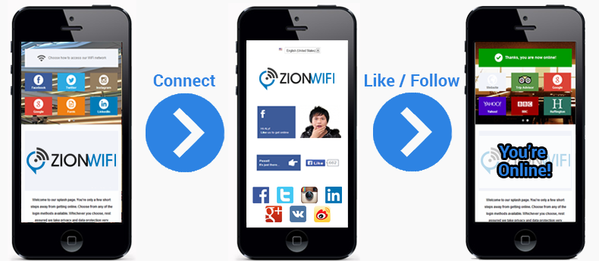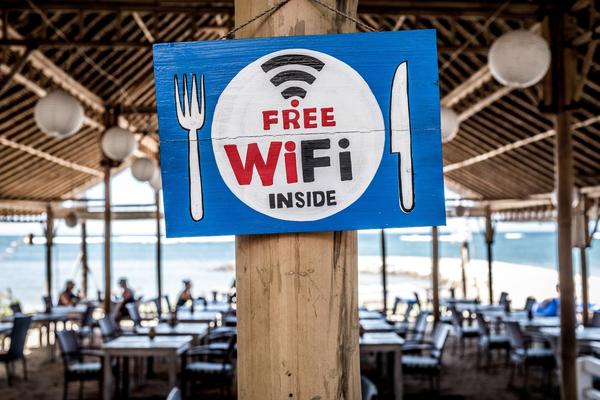 I recently spent a month in Vietnam. My last trip to Southeast Asia was six years ago, in 2012, and WiFi was something you wanted but it wasn’t readily available.
I recently spent a month in Vietnam. My last trip to Southeast Asia was six years ago, in 2012, and WiFi was something you wanted but it wasn’t readily available.
But that’s no longer the case. Everywhere I went, there was free WiFi. Even many of the buses had WiFi (and it worked!).
Retailers in Vietnam are on to something: According to data from Cisco, 96% of consumers prefer to shop at stores that have free WiFi, and they’re also more likely to return. And Oracle found that almost 60% of shoppers actually demand in-store WiFi.
Let’s dive into what WiFi marketing is and how retailers can leverage it to improve their businesses.
What Is WiFi Marketing?
WiFi marketing is when retailers provide wireless internet access to shoppers and then use that as a channel to communicate messages and promotions. It’s just one of the many ways that physical retailers are embracing the digital world — and creating a multichannel experience for their shoppers in the process.
Basically, your WiFi will have a coverage area, likely within the borders of your store. Anyone on a WiFi-enabled device, from smartphones to tablets to laptops, will be able to see and connect to your WiFi network.
Some retailers provide full Internet access. In other words, shoppers can use their devices to surf the web as they normally would. Others only grant access to certain sites or apps, such as your own online store or mobile app. This is more limiting for the browsers, but it also enables you to control the environment and drive them to your promotions.

And with WiFi marketing, you can also mandate that users view, engage with or share content before being granted access to the network. This might be a splash page that talks about your next in-store event or a form where the user must submit their email address.
FURTHER READING: Want to know more about how to use those customer email addresses when you collect them? Read our retailer guide to email marketing.
In some cases, the network will also periodically send additional messages or mandate additional action from the user so they can continue their session on the network without interruption.
What Does WiFi Marketing Look Like?
Here’s how it looks: You walk into a store and join the in-store WiFi network. Upon joining, your phone will redirect to a screen, or splash page, where you’ll likely see a message from the store and more information about the network and its terms of us. You’ll agree to those terms and possibly provide something like an email address or access to your Facebook profile to gain access to the network.

Thinking ahead: The retailer then has some sort of information about you to either add to or create your customer profile. They can send you future targeted messages, be it through email or a targeted social ad, and can use your social media profiles and in-store browsing behaviors to further personalize the content.
FURTHER READING: Personalization is one of the top ways to get a customer’s attention. Learn four ways to personalize the shopping experience for your customers.
The Benefits of WiFi Marketing
The benefits of WiFi marketing in a retail environment are two-fold: There are advantages from both the consumers’ and merchants’ point-of-view.
For the customer:
- Convenience: Shoppers have access to a potentially faster network than their cell phone service provider’s, and they can also save on data usage.
- Improved shopping experience: Almost 62% of businesses that provide free WiFi report that their customers stay longer, according to Devicescape survey. This could indicate that shoppers are enjoying their in-store experiences more, and therefore willing to spend more time with your brand.
For the retailer:
- Increased sales: The main goal for most retailers — driving sales — receives a boost when you engage in WiFi marketing. That Deviscape survey found that half of businesses report that customers spend more money now that they have WiFi.
- Understand your customers: WiFi marketing grants you access to a wealth of data and knowledge about shoppers. You can use these insights to understand your business, the in-store experience, and what makes your customers tick. (And if you have more than one location, be sure to do a comparative analysis, too!)
- Build an audience: Whether you’re collecting email address or social profiles (or both), these customers are becoming a list of interested individuals to whom you can market in the future. Not only that, you’ll have information about their in-store and/or online behavior, which creates a richer customer profile that you can leverage for more targeted ads and promotions. Toronto’s Tokyo Smoke implemented Yelp’s WiFi marketing platform and gained 35 new sign-ons per week — that’s a passive and effortless way to continually grow your list.
- Promote a product or campaign: There are a number of ways retailers can use WiFi marketing to promote their brand. This can start with the message on your splash page, through to retargeted ads and follow-up email campaigns. Bolivia’s Mall Las Brisas, for example, uses WiFi marketing to promote personalized offers based on users’ activity and Facebook profiles. You can also use foot traffic data (such as how they’ve navigated your store, where they’re converting, where they’re spending the most time, etc.) to inform store layout and visual merchandising decisions.
FURTHER READING: Need other accurate ways to measure your store’s foot traffic? Increase customer visits with these methods to gauge foot traffic.
How to Implement WiFi Marketing in Your Store
Getting Your WiFi Network Up and Running
While you could set up your own guest network and provide shoppers with the password, that’s not exactly WiFi marketing in action. Essentially, that works the same as it would if you were to have a guest in your home. You share the password, they surf the net, and then they leave. With true WiFi marketing, you’ll have that opt-in where you collect some sort of data and consent from users.
Therefore, implementing WiFi marketing requires the use of some tools or partnering with companies that can tailor these WiFi services to your specific needs.
Here are a few places where you can look for WiFi marketing services:
Vincent Panico heads up enterprise architect and corporate sales at Moo Moo Networks, a networking hardware retailer that sells products you can use to create a WiFi network in your store.
Panico points to how each tool has its own set of unique features, and integrating various systems can also provide retailers with more capabilities. That’s why they focus on a variety of integrations and plugins for their products (they use Cisco’s Meraki wireless option).
“For example, we use Purple or Bloom Intelligence to capture customer data and convert that to marketing lists,” he says. “Or we’ll use Aislelabs or Mapwize to physically track customer movement.”
One of Moo Moo Networks’ clients, a well-known convenience store chain, uses the latter, more complex benefits of WiFi marketing.
“They track customer movement in the store and place the highest-margin items where customers are most likely to convert,” Panico says. “We also have a furniture store chain that embeds Bluetooth beacons in their display models to target hyper-specific advertising to customers. If someone dwells at a certain chair or couch for a few minutes, that item will be remarketed to them on Facebook, Instagram and via email the next day.”
FURTHER READING: Read more about how to use beacon technology to attract more customers.
Getting Customers to Use Your WiFi Network
 If you’re going to all this trouble to provide a network for your customers, you’ll want to make sure they know about it and actually use it. Leverage in-store signage and the universal WiFi network icon to raise awareness among shoppers. You could also incentivize using the network — maybe they get a discount or free gift for trying out your new fancy new WiFi network.
If you’re going to all this trouble to provide a network for your customers, you’ll want to make sure they know about it and actually use it. Leverage in-store signage and the universal WiFi network icon to raise awareness among shoppers. You could also incentivize using the network — maybe they get a discount or free gift for trying out your new fancy new WiFi network.
If you’re looking to take it up a notch, why not make an event of it and throw a launch party to celebrate your WiFi network? You can generate some buzz about your store, drive foot traffic, and prove to the community that you’re a forward-thinking, innovative brand.
In what ways do you use WiFi marketing in your store? How has it helped you grow your business?

